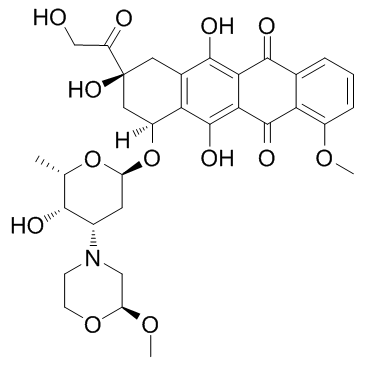Nemorubicin |
| Catalog No.GC36715 |
Nemorubicin (Methoxymorpholinyl doxorubicin) is a Doxorubicin derivative with potent antitumor activity. Nemorubicin is highly cytotoxic to a variety of tumor cell lines presenting a multidrug-resistant phenotype. Nemorubicin requirs an intact nucleotide excision repair (NER) system to exert its activity.
Products are for research use only. Not for human use. We do not sell to patients.

Cas No.: 108852-90-0
Sample solution is provided at 25 µL, 10mM.
Nemorubicin is a derivative of doxorubicin, and has antitumor activity.
Nemorubicin has antitumor activity, with IC70s of 578 ± 137 nM, 468 ± 45 nM, 193 ± 28 nM, 191 ± 19 nM, 68 ± 12 nM, and 131 ± 9 nM for HT-29, A2780, DU145, EM-2, Jurkat and CEM cell lines, respectively[1]. Nemorubicin acts through nucleotide excision repair (NER) system to exert its activity. Nemorubicin (0-0.3 μM) is more active in the L1210/DDP cells with intact NER than in the XPG-deficient L1210/0 cells. Cells resistant to nemorubicin show increased sensitivity to UV damage[3]. Nemorubicin is cytotoxic to 9L/3A4 cells, with an IC50 of 0.2 nM, 120-fold lower than that of P450-deficient 9L cells (IC50, 23.9 nM). Nemorubicin also potently inhibits Adeno-3A4 infected U251 cells with IC50 of 1.4 nM. P450 reductase overexpression enhances cytotoxicity of Nemorubicin[4].
Nemorubicin is converted to PNU-159682 by human liver cytochrome P450 (CYP) 3A4 in rat, mouse, and dog liver microsomes[2]. Nemorubicin (60 µg/kg) induces sifnificant tumor growth delay in scid mice bearing 9L/3A4 tumors, but shows no obvious effect on the tumor growth delay of 9L tumors in mice by i.v. or intratumoral injection (i.t.). Nemorubicin (40 µg/kg, i.p.) exhibits no antitumor activity and no host toxicity in mice bearing 9L/3A4 tumors[4].
[1]. Quintieri L, et al. Formation and antitumor activity of PNU-159682, a major metabolite of nemorubicin in human liver microsomes. Clin Cancer Res. 2005 Feb 15;11(4):1608-17. [2]. Quintieri L, et al. In vitro hepatic conversion of the anticancer agent nemorubicin to its active metabolite PNU-159682 in mice, rats and dogs: a comparison with human liver microsomes. Biochem Pharmacol. 2008 Sep 15;76(6):784-95. [3]. Sabatino MA, et al. Down-regulation of the nucleotide excision repair gene XPG as a new mechanism of drug resistance in human and murine cancer cells. Mol Cancer. 2010 Sep 24;9:259. [4]. Lu H, et al. Potentiation of methoxymorpholinyl doxorubicin antitumor activity by P450 3A4 gene transfer. Cancer Gene Ther. 2009 May;16(5):393-404.
Average Rating: 5 (Based on Reviews and 34 reference(s) in Google Scholar.)
GLPBIO products are for RESEARCH USE ONLY. Please make sure your review or question is research based.
Required fields are marked with *




















